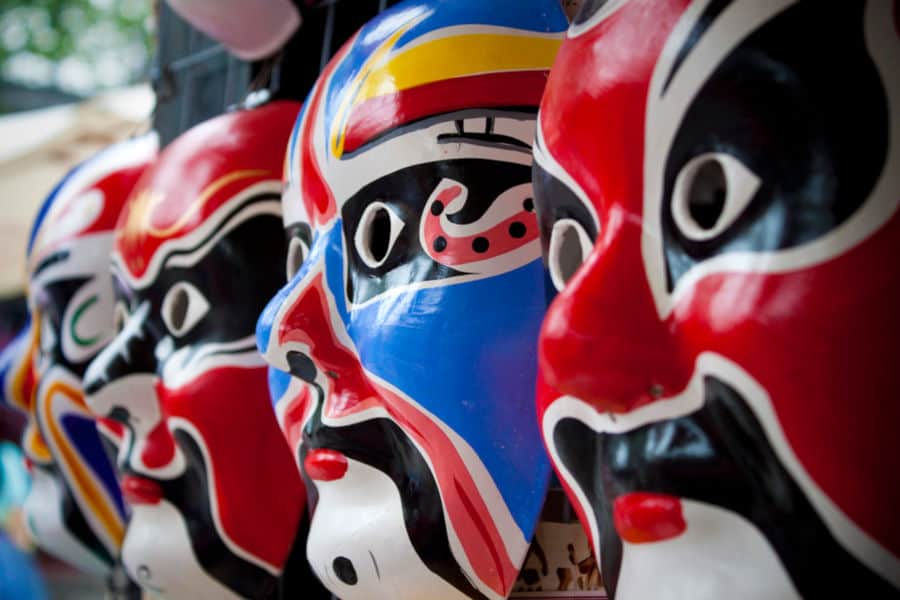Today, Chinese masks are usually associated with Chinese New Year or Chinese opera. Those are the two most common occasions when we can see people wearing them.
In the past, they had more functions – from scaring evil spirits to celebrating various events. If you were wondering what do all these masks actually mean, you will find the answer to that and many other questions here.
Chinese masks history
The history of Chinese masks stretches back over 3,500 years, deeply rooted in ancient spiritual and social traditions. The earliest known masks appeared during the Shang Dynasty (c. 1600–1046 BCE), where they were used in shamanic rituals, ancestral worship, and early forms of theatrical expression. These masks were often made of bronze or wood, symbolizing a connection to the spiritual world and acting as intermediaries between humans and deities.
In early Chinese society, shamans (巫, wū) played a central role in conducting ceremonies for healing, weather control, and exorcism. Masks were a critical tool in these practices, believed to embody spiritual power or the persona of a god or ancestral spirit. Wearing a mask allowed the shaman to transcend human identity and perform sacred rites on behalf of the community.
Masks were also used in “Nuo rituals” (傩仪), which date back to the Western Zhou Dynasty (1046–771 BCE). These rites were performed to drive away plagues and evil spirits, a tradition that would evolve into Nuo opera, which still exists today in rural regions of southern China.
Over time, the use of masks expanded beyond religious and funerary contexts into folk celebrations and social milestones. By the Han Dynasty (206 BCE–220 CE), masks were used in court entertainment and community festivals. This period marked the gradual shift of masks from purely sacred objects to tools of drama, dance, and visual storytelling.
During the Tang (618–907) and Song (960–1279) Dynasties, Chinese theater began to flourish. Masks and face painting evolved into a sophisticated symbolic system, laying the groundwork for the elaborate styles seen in Chinese opera, especially in Peking (Beijing) opera that would rise to prominence during the Qing Dynasty (1644–1912).
Beyond the Han majority, many ethnic minorities in China developed their own mask traditions. For example:
- The Miao and Dong people used wooden masks in seasonal festivals and harvest rituals.
- The Yi people carved masks for ancestral veneration and rain-making ceremonies.
- The Tibetan tradition incorporated masks into Buddhist religious dances such as Cham, blending Indian and indigenous animistic influences.
Each group’s mask tradition reflects its unique cosmology, history, and interaction with nature, further enriching the diversity of Chinese mask culture.
Chinese masks meaning
As we have already mentioned, some masks were made to protect people from evil spirits. Their purpose was to scare evil spirits and to drive them away from people and their houses.
The meaning of Chinese masks that were used during funerals was to scare away evil spirits and make sure that the soul will rest in peace.
On the other hand, the meaning of masks used during celebrations was to wish luck and pray for happiness. When it comes to theater masks, every color had different meaning but we will explain that in more detail later on.
Check out our “Free Culture Library“. We have compiled some great free resources, about Chinese culture, for your research.
Types of Chinese masks
There are more ways to classify Chinese masks. We usually classify them according to the function for which they were used. They can also be classified according to the region where they were used because there are many ethnic and regional differences.
Some of the most famous are exorcising masks, shamanic masks, Sorcerer’s mask, Tibetan mask, and theater masks. We will try to explain the differences among them.
| Mask Type | Primary Use | Region of Origin | Associated Ethnic Groups |
|---|---|---|---|
| Exorcising Mask | Drive away evil spirits, military praise | Central Plains | Miao, Dong, Yao |
| Shamanic Mask | Exorcisms, funerals, totem worship | Northern China | Mongolian, Ewenki, Man |
| Sorcerer’s Mask | Welcoming deities, ceremonial prayers | Yunnan, Guizhou | Jinuo, Jingpo, Dai, Wa |
| Tibetan Mask | Festivals, temple display, symbolic characters | Tibet and surrounding areas | Tibetan |
| Opera Mask | Theater and opera performances | Nationwide (Han cultural core) | Han |
| New Year Mask | Celebration, fortune and happiness | Nationwide | Broadly used |
Chinese exorcising masks
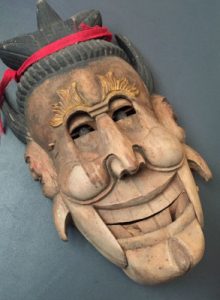
Exorcising masks originate from the Central Plains of China. As the name says, they were initially used in exorcising rituals to drive away evil spirits. With time, they became popular in army because they were praising the success of military officers.
Some ethnic groups combined exorcising masks with the totem worshiping. Exorcising masks are still popular among some ethnic minorities such as Miao, Dong, Yao, and others.
Take a look at these awesome Opera Masks.– Aff.link
Chinese shamanic masks
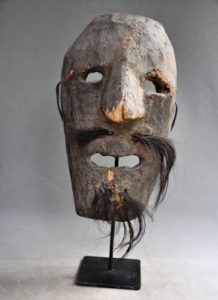
Shamanic masks are ancient mask that originate from the north of China.
They derive from the totem worshiping and the shamanic culture. Similar to exorcising masks, shamanic masks were used in exorcising and funerals.
They just originate from a different region than exorcising masks. Shamanic masks were usually made in dark tones, to scare the ghosts. Today, they are used by some ethnic groups such as the Mongolian, Ewenki, and Man.
Chinese Tibetan mask
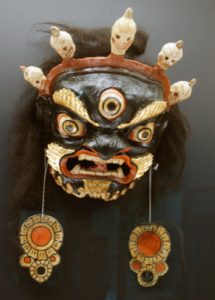
Tibetan masks were usually made in the form of animal, human or demon. Every character had a unique personality and they used metaphors and symbols to represent character traits. They are colorful and very beautiful.
It can be noted that they were carefully made, thinking about each detail. If you look Tibetan mask carefully, you will notice that they used many different materials, such as pearls and shells, to make details.
Tibetan masks were usually worn during important celebrations and festivals. On ordinary days they were displayed in temples, so everybody could admire them.
Chinese theater masks
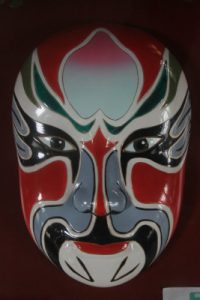
For many people, the first association when someone mentions Chinese opera, are masks. That is normal because masks are important part of Chinese art, especially when it comes to theater, opera, and dance.
Masks have been used through the history of Chinese theater and today they are very popular in ethnic operas. One very interesting detail is that every color symbolizes certain characteristic!
Symbolism in Colors and Facial Designs of Opera Masks
In Chinese opera, masks and facial makeup serve a dual purpose: they enhance theatrical performance while conveying complex layers of symbolism. Each color and design used in opera masks communicates something about a character’s personality, status, and moral alignment, offering the audience instant visual cues.
Color Symbolism in Opera Masks
Colors are not chosen at random—they follow a codified tradition rooted in centuries of performance. Here are some of the key color associations:
- Red: Denotes loyalty, bravery, and righteousness. Characters with red masks are often heroic and noble, such as the warrior Guan Yu.
- Black: Indicates integrity and impartiality. It is typically used for characters who are neutral, bold, or fair-minded.
- White: Signifies treachery, cunning, and deceit. Villainous figures like Cao Cao are portrayed with white facial makeup.
- Blue: Represents fierceness, stubbornness, and an unyielding personality. Blue masks often appear on outlaws or unconventional heroes.
- Green: Suggests impulsiveness, violence, and a strong, unrestrained character.
- Purple: Conveys a sense of dignity, calmness, and wisdom—often used for elder statesmen or thoughtful generals.
- Yellow: Associated with cruelty, ambition, and ferocity.
- Gold and Silver: Reserved for supernatural beings such as gods, spirits, and demons. These metallic hues signal a character that exists beyond the human realm.
Facial Patterns and Their Meaning
Beyond color, the design and shape of the facial patterns offer additional layers of meaning:
- Symmetrical designs often indicate a character with moral clarity or balanced emotions.
- Spirals, flames, or exaggerated eyebrows can show emotional volatility or mystical power.
- Cross-shaped forehead patterns mark a loyal or heroic warrior.
- Sharp, angular lines may signal a harsh or menacing personality, while rounded patterns suggest openness and warmth.
Each pattern is meticulously applied using brush techniques that require years of training. The fusion of color and pattern allows the audience—even those unfamiliar with the story—to instantly understand a character’s essence from the moment they step on stage.
This visual language is not only an artistic achievement but a practical tool in Chinese opera, where symbolism and allegory take precedence over realism. The opera mask thus becomes a powerful storytelling device, condensing a character’s inner world into a single, striking image.
Read more about Chinese Opera and Masks in our article: “Everything You Need to Know about Chinese Opera” – Opens in new tab
Chinese Sorcerer’s masks
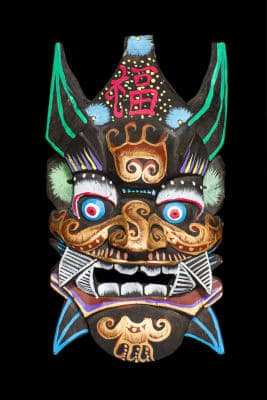
Sorcerer’s masks were used in regions Yunnan and Guizhou. They were worn by groups of people during ceremonies that were held to welcome gods and good spirits.
Sorcerer’s masks were said to bring positive energy and that’s why they were also used during organized prayers for better future. They were also present at funerals, and their purpose was to make sure that departing soul will have peace.
They are also connected to the totemic worshipping. Today, they can be found in many ethnic groups such as Jinuo, Jingpo, Dai, Wa and others.
Chinese New Year masks
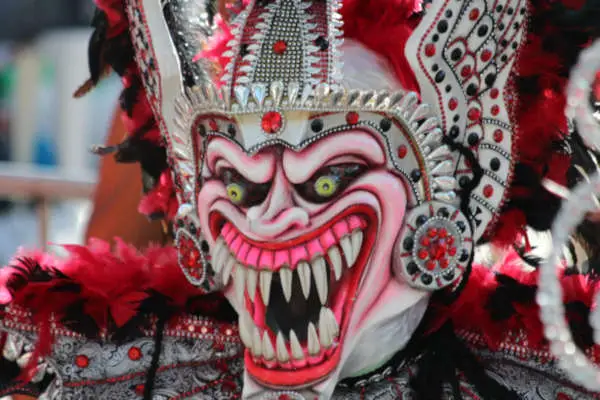
One of the most important celebrations in China is Chinese New Year! Celebration lasts for several days and it is a great opportunity to have fun but also to learn more about Chinese culture.
Chinese New Year masks are made on purpose for that date and they are used only during that time of the year. They are colorful and full of details. New Year masks symbolize happiness and prosperity.
There are many different New Year masks, but the most important is Dragon mask! Dragon is a symbol of fortune and wealth in Chinese culture, so it is clear why they pay special attention to this mask.
Dragon masks are red and they are more complex than other masks. They have rich decoration and details in gold and blue color. Sometimes, dragon mask is so big that several people have to carry it!
We mentioned only the most famous Chinese masks. There are many more! Every part of China has its own traditions so they made different masks. Those masks have influenced every aspect of Chinese culture and art. Chinese people are especially proud of their masks and they can not imagine New Year without traditional masks.
Take a look at these awesome Opera Masks.– Aff.link
Regional Variations and Ethnic Mask Traditions
China is home to 56 officially recognized ethnic groups, and many of them have distinct mask-making traditions. For instance:
- Nuo Masks: Found primarily in southern China (Guizhou, Jiangxi, Hunan), these are used in the Nuo opera, a ritual performance meant to expel evil and diseases. Nuo masks are often grotesque and exaggerated, representing both deities and demons.
- Yao and Zhuang Ethnic Groups: In Guangxi and surrounding provinces, masks are carved from wood and used in village ceremonies, often paired with dances that dramatize local myths and origin stories.
- Qiang Masks: The Qiang people of Sichuan use masks during the Qiang New Year, often integrating goat horns or animal features to connect with ancient animistic beliefs.
Each ethnic tradition reflects its own belief system, environment, and folklore, making Chinese mask culture incredibly diverse and region-specific.
| Region | Material Used | Unique Features |
|---|---|---|
| Guizhou | Wood (camphor, pine) | Grotesque faces, strong Nuo tradition |
| Tibet | Wood, cloth, metal | Highly detailed, use of beads, shells, symbolic animals |
| Jiangxi | Papier-mâché, clay | Bright colors, smooth texture |
| Inner Mongolia | Fur, leather, wood | Tribal motifs, animal elements |
| Sichuan | Painted wood | Expressive features, used in changing-face (变脸) opera |
Mask-Making Craftsmanship and Materials
The craft of making traditional Chinese masks is an art form passed down through generations. Depending on the purpose and region, masks may be carved from wood, molded from papier-mâché, or even made from metal and lacquer.
- Wooden masks are the most traditional and are often made from basswood or camphor, chosen for their softness and aromatic properties believed to repel evil.
- Painting is done with natural pigments and minerals, applied in layers with meticulous brushwork to create vibrant, long-lasting colors.
- Adornment may include horsehair, feathers, silk, or even real gemstones in ceremonial masks used for temple displays or royal festivities.
In many rural communities, mask carving is considered a sacred profession, and artisans perform purification rituals before beginning the process.
Masks in Contemporary Chinese Festivals and Tourism
In modern times, Chinese masks are more than ceremonial—they’ve become symbols of cultural identity and heritage. Cities like Lijiang, Fenghuang, and Chengdu host mask-dancing festivals where performers from different ethnic groups showcase their traditional dress and masks.
Additionally, Chinese mask motifs have entered the fashion and souvenir industries, appearing on textiles, porcelain, and wearable art. Tourists often purchase replica opera masks or handcrafted Nuo masks as keepsakes of their cultural experience.
Government-sponsored programs and UNESCO recognitions have also helped preserve mask-making as an intangible cultural heritage, with dedicated museums and workshops open to the public.
Stay in Touch
 Join our newsletter by using the forms on this website or click here!
Join our newsletter by using the forms on this website or click here! Follow us on Google News
Follow us on Google News Follow us on Facebook
Follow us on Facebook
Images:
- Featured Image by “Masks” by Ashley.Wang. is licensed under CC BY-ND 2.0
- Exorcising mask by masksoftheworld.com
- Shaman mask by jonhspecialobjects.nl
- Tibetan Mask by “Tibetan Mask” by Tolka Rover is licensed under CC BY-NC-SA 2.0
- Opera Mask by “china traditional mask” by Samuel Huron is licensed under CC BY-NC-ND 2.0
- Sorcerer’s mask by hasshe.com
- Chinese New Year mask by uihere.com

